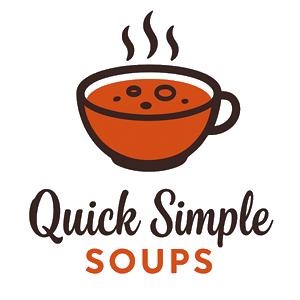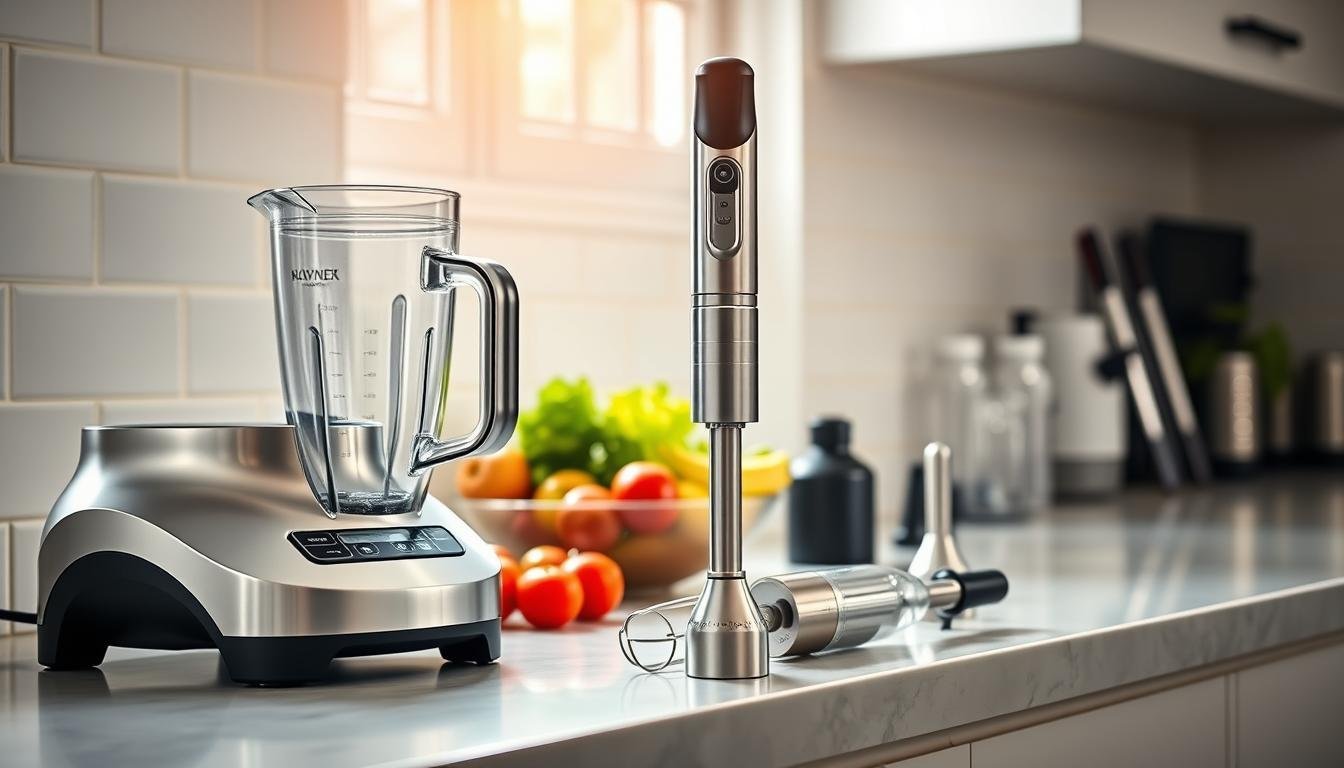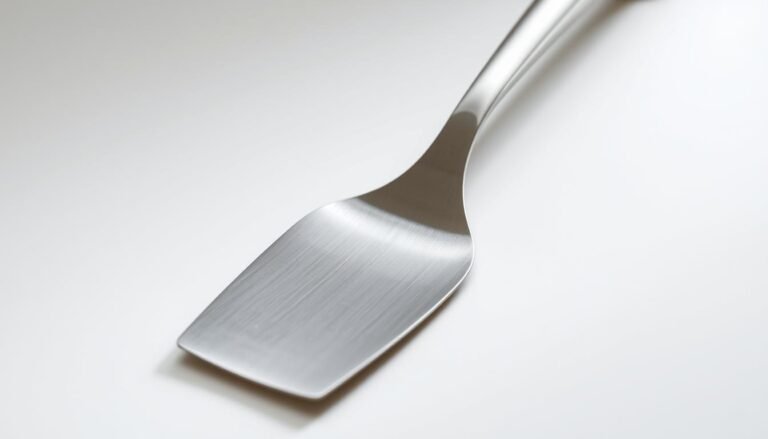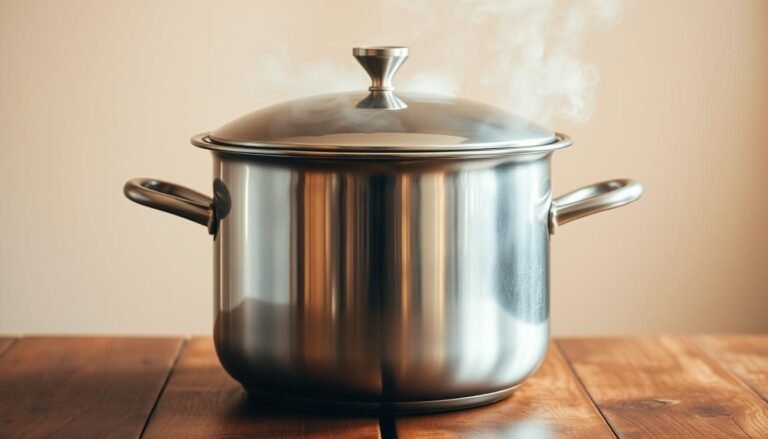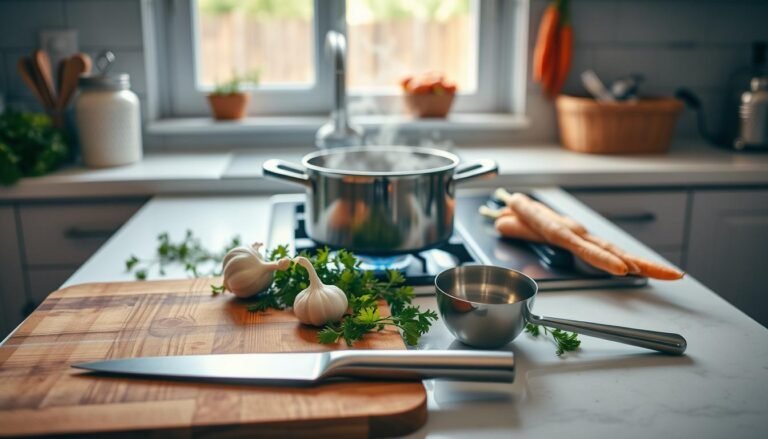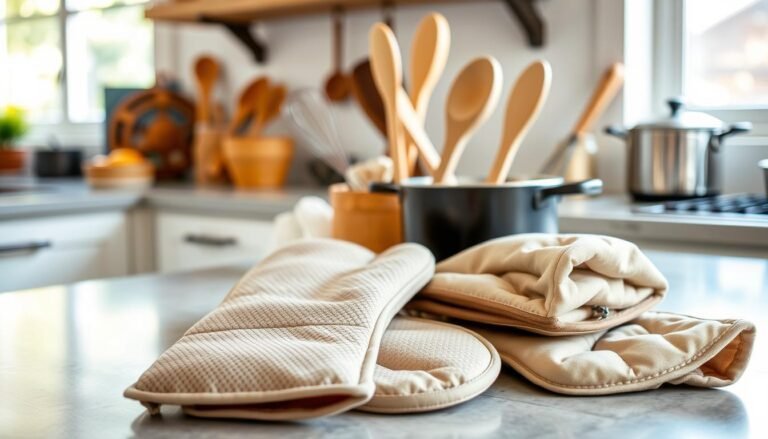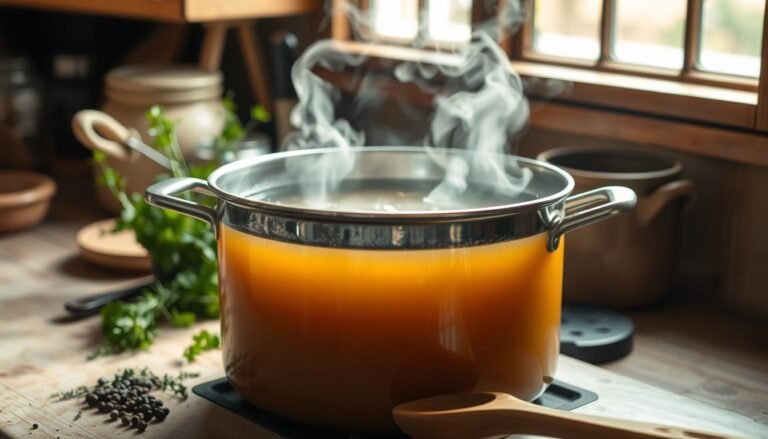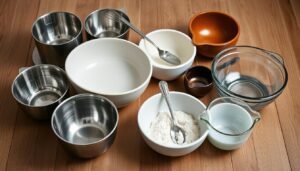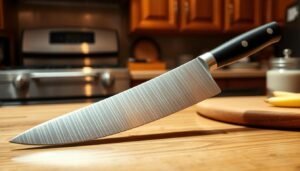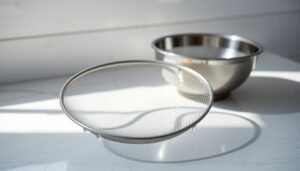Disclosure: This Post Contains Affiliate Links; We earn a commission on purchases.
Thinking about getting a new blender? It’s key to think about your kitchen style and how you cook.
Don’t jump to buy a regular blender without a thought. Look at an immersion blender too. See which one is better for you.
Knowing what each blender can do will help you decide. This article will show you the main differences. It will help you pick the best blender for your cooking.
Key Takeaways
- Think about your kitchen style and cooking habits before buying a blender.
- Compare the features and benefits of countertop blenders and immersion blenders.
- Understand the unique advantages of each type of blender.
- Make an informed decision based on your culinary needs.
- Choose the right blender to enhance your cooking experience.
Understanding Blenders and Immersion Blenders
Choosing between a traditional blender and an immersion blender depends on knowing their differences. Each has special features and benefits. They are good for different kitchen tasks.
What is a Traditional Blender?
A traditional blender, also known as a countertop blender, sits on your counter. It has a pitcher and a motor base. It’s great for blending smoothies and pureeing soups.
These blenders are powerful and versatile. They are a must-have in many kitchens.
What is an Immersion Blender?
An immersion blender is a handheld device. It blends ingredients right in pots, pans, or bowls. It’s perfect for soups, sauces, and other liquids.
Immersion blenders are easy to use. They save you from moving hot or big contents to another blender.
Basic Differences at a Glance
- Design and Portability: Traditional blenders are bigger and harder to move than immersion blenders.
- Usage: Traditional blenders can do many things. Immersion blenders are best for liquids.
- Cleaning: Immersion blenders are simpler to clean. They have fewer parts and can be rinsed easily.
If you want to try different kitchen appliances, including blenders, check out recommended products here.
Blender or Immersion Blender: Key Features Compared
To choose the right kitchen tool, let’s look at the main differences between blenders and immersion blenders. Knowing these differences helps you pick the best appliance for your kitchen and cooking.
Power and Performance
Blenders’ power comes from their motor strength and blade design. Traditional blenders have stronger motors. They can handle tough ingredients and make smooth mixes.
Motor Strength and Capabilities
Countertop blenders have stronger motors than immersion blenders. Brands like Vitamix and Blendtec make high-performance blenders. These can handle tough tasks.
Blade Design and Efficiency
The blade design is key to a blender’s efficiency. Traditional blenders have complex blades for better mixing. Learn more about blade design in blenders.

Versatility and Attachments
Both blenders and immersion blenders have attachments for more uses. Traditional blenders have extra jars or blades. Immersion blenders have different speed settings and heads.
Size and Storage Requirements
Immersion blenders are smaller and easier to store. They’re perfect for small kitchens.
Cleaning and Maintenance
Cleaning is important. Immersion blenders are easy to clean because of their simple design. Traditional blenders need more effort to clean, with their many parts.
Price Points and Value Considerations
Choosing between a blender and an immersion blender depends on their prices and value. It’s key to look at the cost, how long it lasts, and how well it works.
Cost Range for Quality Blenders
Blenders can cost from under $20 to over $500. High-quality blenders from top Blender brands usually cost between $100 and $300. This price range offers a good mix of quality and price.
During a Blender sale, you can find top models at lower prices. This makes them more accessible.
Cost Range for Quality Immersion Blenders
Immersion blenders are generally cheaper, starting at around $15. They can go up to $150 for models with extra features. The Best Immersion Blenders usually cost between $50 and $100.
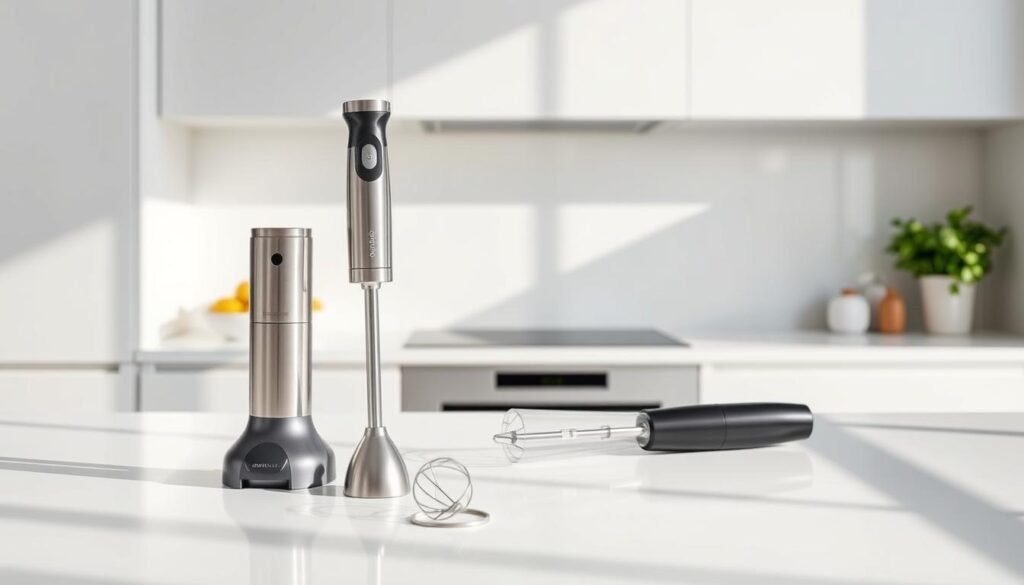
Long-term Value and Durability
Looking at long-term value, durability and maintenance costs are key. Even though high-quality blenders might cost more upfront, they save money in the long run. They are reliable and work well.
An Immersion Blender comparison with traditional blenders should also consider replacement parts and cleaning ease.
In summary, while the initial cost matters, a blender’s true value comes from its performance, durability, and how it fits your kitchen needs.
Kitchen Tasks and Recipe Suitability
Choosing between a traditional blender and an immersion blender affects your cooking. Each has strengths for different recipes.
Best Uses for Traditional Blenders
Traditional blenders are great for blending strong and thick mixtures. They handle frozen ingredients well.
Smoothies and Frozen Drinks
They make smoothies and frozen drinks smooth. This is hard to do with immersion blenders.
Purees and Thick Mixtures
They’re also good for pureeing soups and thick mixtures. This makes them very useful in the kitchen.
Best Uses for Immersion Blenders
Immersion blenders blend right in pots and pans. They’re perfect for some kitchen tasks.
Soups and Hot Liquids
They’re great for soups and hot liquids. You don’t have to move hot contents to a blender.
Small Batch Processing
They’re also good for small batches. You can blend small amounts right in their containers.
Overlapping Capabilities
Traditional and immersion blenders share some tasks. Knowing this helps choose the right blender for recipes.
For example, both can make sauces. But traditional blenders are better for big batches.
Matching Your Kitchen Style and Cooking Habits
Your kitchen style and cooking habits are key in choosing between a traditional blender and an immersion blender. The right choice makes cooking better and fits your kitchen well.
For Minimalist Kitchens
If you have a minimalist kitchen or little counter space, an immersion blender is great. It’s small and easy to store, keeping your counters clear.
For Gourmet Home Chefs
Gourmet chefs might like the variety and detail of traditional blenders. These blenders have many settings and attachments for different dishes.

For Small Spaces and Apartments
In small places, the immersion blender’s small size is a big plus. It’s perfect for blending soups, sauces, and more right in the pot.
For Family Cooking
For families, a traditional blender is better. It can handle big amounts. It’s great for smoothies, soups, and family meals.
Knowing what you need and like is important. It helps you pick the best blender for your kitchen.
Conclusion: Making the Right Choice for Your Kitchen
The choice between a traditional Blender and an Immersion Blender depends on your needs and likes.
Think about your kitchen style, cooking habits, and favorite recipes. A traditional Blender is great for big batches of smoothies or soups. But, if you like to puree food right in the pan, an Immersion Blender is perfect.
Also, consider your kitchen space and budget. Blenders take up more room, but Immersion Blenders are cheaper and fit easily in drawers. Knowing the special features of each will make your cooking better and more fun.
FAQ
What are the main differences between a traditional blender and an immersion blender?
Which type of blender is more versatile?
How do I choose the right blender for my kitchen style?
What should I consider when evaluating the price of a blender?
Are immersion blenders easy to clean?
Can I use a traditional blender for soups and sauces?
What are some top-rated blender brands?
Can I use an immersion blender for frozen ingredients?

Ryan Conlon is the comfort food fan behind QuickSimpleSoups.com, where he shares easy soup ideas, smart shortcuts, and helpful tips for busy home cooks. Ryan believes a good bowl of soup doesn’t need to be complicated—and he’s here to prove it. Whether you’re looking for quick weeknight meals or cozy classics with a twist, Ryan’s simple approach helps you serve up satisfying soups with minimal effort.
Subscribe to Our Newsletter
